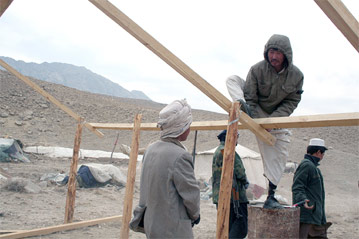Pakistan earthquake update: Winter late but harsh
Pakistan earthquake update: Winter late but harsh
Winter in northern Pakistan has come late but with a vengeance, unleashing over the past weekend three days of rain and snow on people already suffering after the October 8 earthquake. The bad weather, which started Saturday night after a relatively mild December, grounded relief flights for three days until Wednesday and caused landslides that cut off road access to many quake-hit areas.
The severe cold wave has plunged night-time temperatures below zero, with -2 degrees Celsius recorded in Muzaffarabad and -13 degrees in the highest villages. Next week is expected to bring more rain and snow to the quake zone.
UNHCR, which has responsibility for camp management within the UN team, is currently supporting the Pakistan government and non-governmental organisations in 139 earthquake relief camps - 26 of them planned and 113 spontaneous sites. Altogether, these camps are housing more than 137,000 people left homeless by the quake.
Despite the bad weather, we have not seen any mass movements from the mountains and upper valleys down to our camps at lower elevations. This could be because earthquake survivors have received enough supplies of food, shelter and blankets to stay where they are; or simply because the roads are blocked by landslides. Whatever the reason, we are standing by and have preparations in place to receive 50,000 more people in camps, if necessary. Together with the government, we've expanded existing camps like Meira and Havelian, and set up new camps like Bakrial and Haripur.
The recent storm caused some tents to collapse under the weight of the heavy snowfall, while a few camps were flooded by the relentless rain. UNHCR teams in Bagh, Batagram and Muzaffarabad distributed additional emergency supplies of tents and plastic sheets to camp dwellers affected by the storm, which eased on Tuesday. We are also working with NGOs and the camp populations to improve drainage and the pitching of tents. This involves digging a trench around the tent to prevent water from entering, and a drain to channel water out. Plastic sheets on the roof and ground also help to waterproof and insulate the tent from the cold.
Affected families in a waterlogged extension of Batagram-Maidan camp were asked to move in with host families or to other camps, but they declined. UNHCR and the district's Works and Services department are fixing the drainage and elevating the affected tents with the use of bricks. In Muzaffarabad, 28 families were relocated from Bela Nur Shah spontaneous camp to Chatter Kallas planned camp. In Bagh, two planned camps are near completion and should be able to receive 650 families now living in spontaneous camps by mid-January.
In addition, UNHCR has identified 500 winterized tents from the Norwegian Refugee Council to replace some tents in spontaneous camps that will not withstand the winter.
We recently completed our latest round of winterization, distributing over 250,000 blankets, over 25,000 plastic sheets and some 17,000 mattresses to more than 100,000 people in camps. More blankets and mattresses are on their way.
This weekend, we will also start distributing 40,000 stoves and kerosene in both planned and spontaneous camps. Cautious of tent fires, the government in North West Frontier Province has opted to set up communal heating centres in camps. UNHCR will help to erect these structures with big tents provided by NGOs. The communal heating centres will have about 40 stoves and hold 200 people each. In Pakistan-administered Kashmir, UNHCR will distribute stoves to individual tents due to a lack of space for communal heating centres.
Recognising the fire hazard in tents, we're starting an awareness campaign on fire safety and prevention by providing leaflets on the dos and don'ts of fire usage in camps. We're also supplementing the military's efforts to provide fire extinguishers and buckets filled with sand in case of fire.









